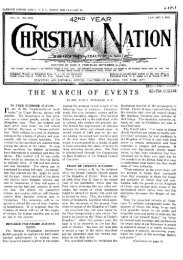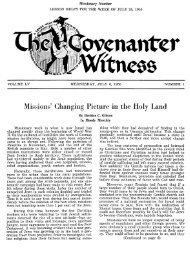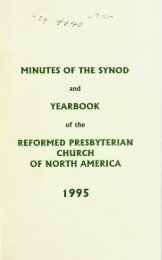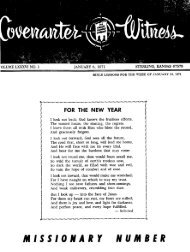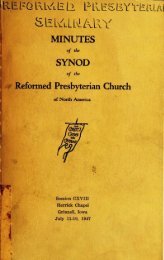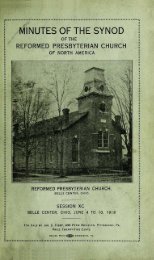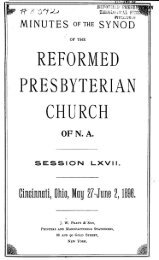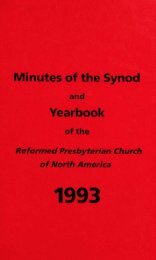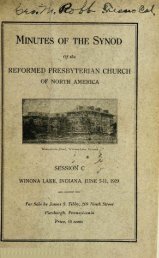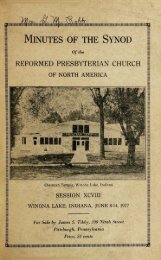Covenanter Witness Vol. 53 - Rparchives.org
Covenanter Witness Vol. 53 - Rparchives.org
Covenanter Witness Vol. 53 - Rparchives.org
You also want an ePaper? Increase the reach of your titles
YUMPU automatically turns print PDFs into web optimized ePapers that Google loves.
Current EventsBy Prof. William H. RussellATOMIC STRIKEA brief but ominous strike recently brought a crisis inthe government's atom-bomb program. The Oak Ridge andPaducah plants ofthe Atomic Energy Commission areoperated, under government contract, by the Union Carbideand Carbon Corporation. When the company refused demands for a wage increase, about 4,500 C.I.O. workers lefttheir jobs. An equal number of A.F.L. men stayed at work.Rivalry between the two unions was partly responsible forthe walkout. The government immediately prepared tosecure a Taft-Hartley injunction forcing the strikers backto work. But the Oak Ridge employees returned after twodays, and the Paducah workers gave up a day later. Thestrike undoubtedly made poor public relations for the C.I.O.This was the first major strike of atomic workers, andwill lead to a reexamination of labor policies in this field.The position of the workers is unusual, in that technicallythey are employed by private industry, but the governmentinsists that they have no moral right to strike.RACE AND POLITICSThe Union of South Africa will hold provincial elections in August, and the Nationalist party of Prime Minister Daniel Malan is putting on a vigorous campaign. Theoffices at stake are not imporant; but Malan hopes tostrengthen his party sufficiently to amend the constitution,so as to eliminate the mixed-blood Negroes from the votingrolls in Cape Province, the largest of the Union's fourprovinces. If Malan gains enough power he may also overthrow the Supreme Court, which has blocked some of hismore extreme measures.South Africa has 1,000,000English-speaking whites,1,600,000 whites of Dutch descent who form the bulk ofthe Nationalist party, and 1,000,000 "Cape Coloreds," orNegroes with white blood. The latter hold the balance ofpower, which is why the Nationalists want to disfranchisethem. Unfortunately, the Negro <strong>org</strong>anizations which aremost active in politics have been infiltrated somewhat byCommunism and the Nationalists are likely to use this asan excuse to stamp them out.LABOR PEACEWalter Reuther and Ge<strong>org</strong>e Meany, presidents of theC.I.O. and A.F.L., recently celebrated the ratification oftheir no-raiding pact, which is intended to restrict competition between branches of the two federationsThree important labor leaders, however, did not adhere tothe pact. They are John L. Lewis of the United MineWorkers, David McDonald of the C.I.O. United Steel Workers, and Dave Beck of the A.F.L. Teamster Union. Instead,these three have formed their own alliance, and apparentlyintended to exert some political influence. McDonald wona major victory when the steel industry granted his1,200,000 workers a five cent an hour pay raise and otherbenefits, totalling nine to twelve cents an hour. As expectedsteel prices were promptly raised, by $3 a ton. Other majorindustries are likely to follow the same pattern.TEMPERANCE FOR RUSSIAThe rulers of the Soviet Union have recently decreedan all-out temperance campaign. The Communist press isJuly 21, 1954highlighting stories of crime and social abuses causedby drink, and party and social <strong>org</strong>anizations are beingcriticized for failing to provide worthwhile leisure activities.The journals of the Communist youth movement are leadingthe crusade. The effects of drinking on industrial productionare mentioned, but the main emphasis has been on thepersonal and social evils. The Communist regime imposedcomplete prohibition up to 1924. Since World War n,however, there has been almost no restriction. The Russians traditionally drink hard liquor, especially vodka, andlots of it. American-type whisky has recently been importedas a novelty. Human nature is much the same everywhere,and it is interesting to find that the Communists havemany of the same social problems that we face.TROUBLED WATERSRelations between India and Pakistan are again seriously disturbed. The issue is the opening of a new dam onthe Sutlej River, in the Indian province of East Punjab. Thedam is part of a huge flood-control and irrigation project,with a main storage dam still to be built. The flood watersof the Sutlej River will be diverted to irrigate nearly400,000 acres of new land in East Punjab and adjoiningprovinces, which has been one of the worst famine areas ofnorthern India. But the river eventually flows into Pakistan, where the water is used to irrigate an grain-importantgrowing area. The Pakistan government is protesting bitterly against the opening of the new Indian dam withouther consent. Pakistan fanatics claim that India will reducePakistan to "an economic and political vassal."An Indianspokesman, however, claims that neither country is usingmore than ten per cent of the available river water. Thequestion may be taken to the U. N. for arbitration. Thereis a very similar dispute between Transjordan and Israel.NEW TRAINSThough American railway passenger cars have gradually adopted air-conditioning, observation domes and otherluxuries, their basic construction has not changed for manydecades. They may be revolutionized, however, if the railroads decide to adopt a radical new design which has beensuccessfully used in Europe. Known as the "Talgo," thecars are built mainly of aluminum, weighing only one-thirdas much as our conventional cars. Passengers ride betweenthe wheels instead of over them, so that the cars are muchlower. Curves can be taken nearly twice as fast, with thesame degree of safety, as with the old-type cars. The carscost less to build, and because of its light weight the trainuses only two-fifths the fuel of a traditional one. The RockIsland Railroad has already ordered one of the new trains.to be delivered in a year and a half, and Eastern lines areconsidering its adoption.SOMETHING BETTERThough the Talgo train was developed in Spain, American inventors have not been idle. If you find the labor ofwinding your wrist watch too fatiguing, there is now a tinydry cell battery which will do the work for you. It willrun a watch for at least a year, like an electric clock, andcan also be used to power other delicate instruments. Dye(Continued on page 40)35



